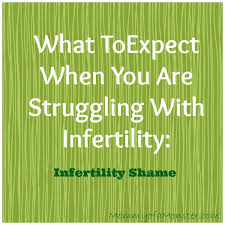I came across this quote recently and it made me start to think. What is the appropriate way to deal with/ manage infertility? You would think after four years, I would know the answer. Unfortunately I do not. I am not sure if it is because we are going to start treatment soon but I am starting to feel a little crazy. I’ll tell you why.
Some days I wake up and do not even think about the fact that I am a failed baby maker. Also, sometimes I go out with my husband and friends and even think about how nice it is that we have the freedom to do so. Unlike our friends with kids, our schedules are more flexible and we do have more free time to do what we want. Other days, I wake up and all I can think about is getting pregnant. Seemingly innocuous things like commercials for diapers make me fall apart.
On occasion, infertility make me really angry. I become jealous of other couples who seem to get pregnant with little effort while I try everything under the sun without success. Knowing how crappy infertility is, I should be thrilled when other people do not have to deal with it. Also, I love my husband more than anything and I hate how infertility has put a stress on our marriage. We will work it out like we always do but it still sucks. I also get really mad at people who seem to have the solution to my problems or give me possible reasons as to why I have not yet gotten pregnant. While I try to stay positive, some days are easier than others and I often feel that I am criticized for my negativity. You know that being negative prevents you from getting pregnant right…..ugh!!!
At the same time I am reminded of loved ones who are dealing with far more grim situations. My own parents lost their only son at age 19. Other loved ones have battled (and sometimes lost their battle to) cancer and other conditions. Some friends and family members struggle with serious financial issues and worry about things I never think about (like buying foods and maintaining housing).
It is wrong for me to allow infertility to permeate my life the way it does when things could be so much worse? On the other hand, isn’t it okay to think about how my life would differ if I did not have to constantly fight an (as of now) losing battle against infertility? Lately, I have managed infertility and worries about our impending treatment by going on autopilot. I have been given suggestions on how to handle my feelings about this. Many people tell me I should be positive and expect the treatment to work. Is that what I should be doing? If so, it is hard to do. Nothing has worked in the past and it is difficult to believe that things will be different. I do really hope that it works! I know there is a chance or I would not try. Realistically, I know fertility treatment success rates are not that high and there is a good chance that it will not work. Is this negative or just realistic? To make things stranger, there are times where I am super optimistic about it. I even start thinking about baby names and how we would announce a pregnancy when it all works out. I do not know why I change my perspective and why I can not just stay positive all the time. If I am thinking about it the wrong way, it is really hard to change how I feel. Four years of disappointment is a long time. A lot of time I just want to hide and have people leave me alone. I do not know why I feel like this as well because I have a wonderful group of friends. Many of them have been there for me throughout this journey and it is wrong of me to want to them leave me alone sometimes. Seriously…I think I may be going crazy.




















 Aspartame is one of the best food ingredients exhaustively studied and it has been tested in more than 100 scientific studies prior to FDA approval in 1981. The studies were conducted in laboratory animals and humans, including infants, children, healthy adults, lactating women, diabetics, obese people and people with the rare genetic disease phenylketonuria (PKU). In addition to the Food and Drug Administration (FDA), the Joint Expert Committee on Food Additives (JECFA) of the World Health Organization (WHO) and Food and Agriculture Organization (FAO), the Scientific Committee Food (SCF) of the European Union and regulatory agencies of more than 100 countries have reviewed aspartame and found that its use was safe.
Aspartame is one of the best food ingredients exhaustively studied and it has been tested in more than 100 scientific studies prior to FDA approval in 1981. The studies were conducted in laboratory animals and humans, including infants, children, healthy adults, lactating women, diabetics, obese people and people with the rare genetic disease phenylketonuria (PKU). In addition to the Food and Drug Administration (FDA), the Joint Expert Committee on Food Additives (JECFA) of the World Health Organization (WHO) and Food and Agriculture Organization (FAO), the Scientific Committee Food (SCF) of the European Union and regulatory agencies of more than 100 countries have reviewed aspartame and found that its use was safe.










